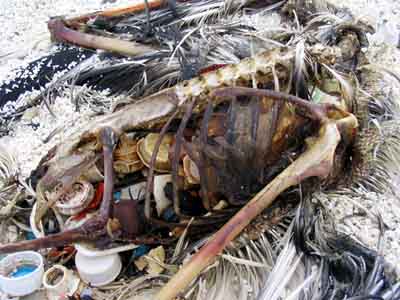Polution
Pacific Ocean Plastics
I think that this is a scary thought to think that an area as large as Texas is covered with plastic. Plastic is supposed to be the one most incredible invention of the 19th century (with electricity, the light bulb, radio, television, computers, and much much more...)
There are many problems with Plastics. One as they age they release bad chimicals. Bad for everyone in contact with said plastics. You babies drinking fake milk (sorry scientifically proven formula) in a plastic bottle is a good example of a person at risk of plastics.
Now, all the large cities in the US have a large hill somewhere which was built in about 50 years. That hill is trash. Each large city has enough trash on these hills to cover the whole of texas by 1 to 2 inches.
In a way, this is not so bad. But plastic biodegrade very slowly. It's better than nuclear waste, but it takes a very long time. We'll have to keep these hills for a while (but I'm sure some real estate resellers will be happy to sell you your 1 acre of land on that hill!)
Okay... now imagine that you put that amount of trash in the Ocean. Who would want to do that, you'd ask? Well... say you lose a bottle cap. Are you going to spend a whole day trying to find it again? I bet you won't. It's nothing. Just a cap. True. Now imagine that you have 7 billion people on planet Earth (Hard to imagine that? Wake up man!) and imagines that 0.001% of them lose a cap each week. That's 7 million caps. A week. Is that starting to sound a bit scary? Next, imagine that these caps somehow fall in the stream that goes to the river that goes to the ocean. 7 million caps a week in the ocean. Well... okay... say you have 50% "loss" along the way. That's still 3.5 million caps.
There are areas in the Pacific Ocean that are not being navigated for it is not easy to get out of them and it is not a route to anywhere. The currents are used by commercial boats. The currents go around that are. So people, in general, do not go there. Plus, because of the currents and such, that area was never a good place to fish since there wasn't much to eat there. Oh! Yeah! Now there is plenty to eat... well... it's covered by floating plastics. Flotsam.
And this area is as large as Texas. I dunno the size of California compared to Texas, but that's certainly about the same. Imagine California covered, all over, by a "thin" layer of plastic. How nice would that be?!
And California is about the same size as France. Maybe we could cover France with a layer of plastic?
Ah! And remember I was speaking of these hills outside of our large cities (those that real estate people will sell you within the next 100 years.) So... let's say we have 50 States in the US, 24 in Europe. Each State has 3 large cities (it is probably more). That's 74 x 3 = 222 hills of plastics. Plus the Ocean Pacific "hill", 223. Thus we could cover 223 States as large as Texas, California, France. That's the entire land of Earth.
Do you think it is about time to do something about it? Well... it took 50 years to generate the mess, it will take 2 or 3 hundred to clean it. Trust me. It takes much longer for my kids to clean up their mess, and that's quite well contained in the house & small backyard.
Plastic is a killer. It has killed many animals, it has killed kids who thought it would be fun to have plastic on their head, it transformed hormones in boys and girls that cannot procreate normally, and it will continue to affect us in many ways. Plastic kills.
McDonals, Burger Kings and all others that offer these free toys. Great. Kids play with those for a day and within 1 month it is likely in the trash if not lost in a river. What is all that waste for, really?
|
Click below for more info about Plastic Flotsams in the Ocean (photo and comment by Charles Moore)  Bottle caps and other plastic objects are visible inside the decomposed carcass of this Laysan albatross on Kure Atoll, which lies in a remote and virtually uninhabited region of the North Pacific. The bird probably mistook the plastics for food and ingested them while foraging for prey. |